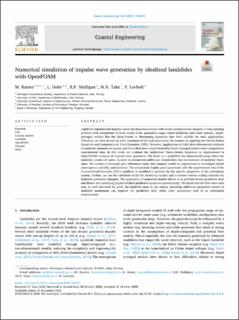| dc.description.abstract | Landslide tsunamis and impulse waves are hazardous events with severe socioeconomic impacts. A long standing problem with simulations of these events is the generation stage, where landslides and water interact. Depth-averaged models like the Saint-Venant or Boussinesq Equations lose their validity for such applications. Therefore, we have to rely on a full treatment of the hydrodynamics, for instance by applying the Navier-Stokes Equations and Computational Fluid Dynamics (CFD). However, applications of fully three-dimensional methods to landslide tsunamis are sparse, and have often been outperformed by depth averaged models when compared to experimental data. In this work, we evaluate the multiphase Navier-Stokes Equations as implemented in OpenFOAM® in terms of impulse wave generation. We focus on a simplified two-dimensional setup where the landslide consists of water, in order to circumvent additional complexities due to treatment of landslide rheologies. We conduct a thorough grid refinement study and compare results to experiments to investigate model convergence, stability, and accuracy. The simulations display good agreement with the experimental data if the Courant-Friedrichs-Lewy (CFL) condition is modified to account for the specific properties of the multiphase system. Further, we use the validated model for sensitivity studies and to review various scaling relations for landslide generated tsunamis. The application of numerical models allows us to perform broad parametric tests and dissect the underlying physics of these predictive equations systematically. We found that the first wave crest may be well estimated by solely the landslide mass in our setting. Including additional properties related to landslide momentum can improve the predictive skill, while other parameters lead to no substantial improvement. | |
